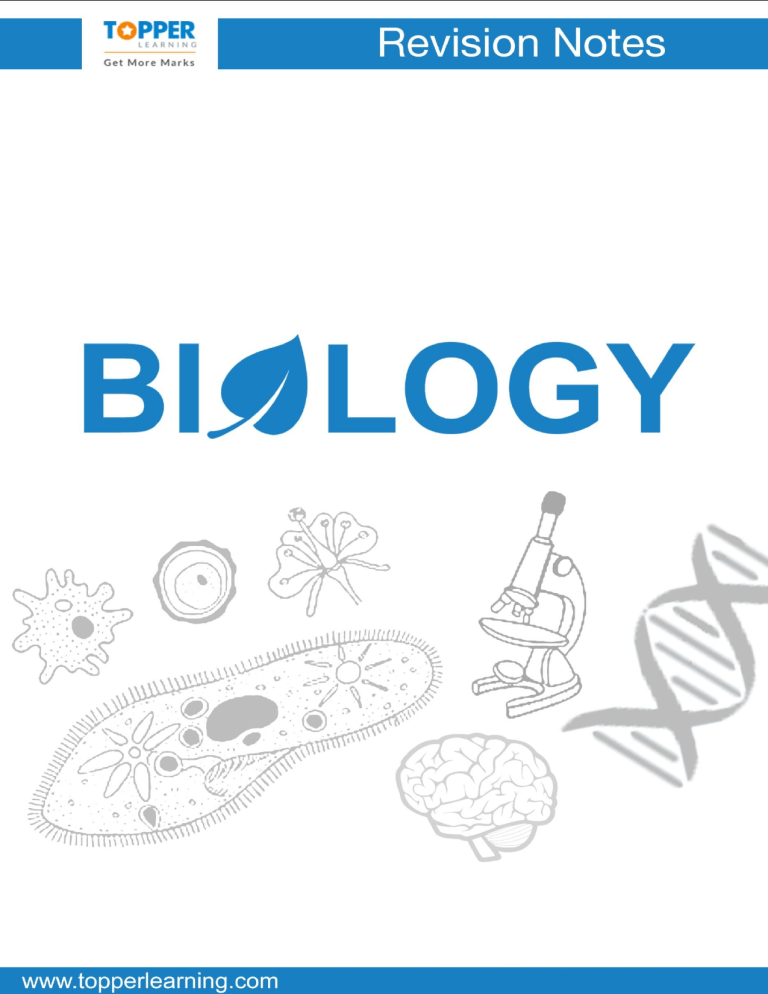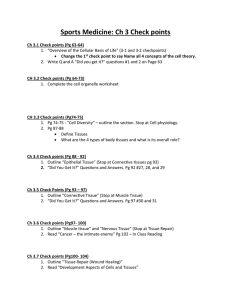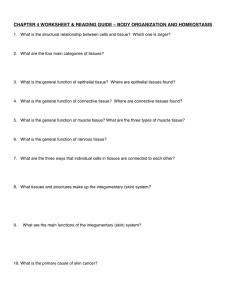
BIOLOGY TISSUES Tissues Levels of Organisation • A cell is the basic structural and functional unit of a living organism. Example: Nerve cell Cell • A tissue is a group of cells having a common origin, similar structure and function and held together by a cementing substance. Example: Connective tissue Tissue • Different types of tissues working together and contributing to specific functions inside the body constitute an organ. Example: Stomach Organ • Different organs coordinate to perform a specific life process and form an organ system. Example: Digestive system Organ system Organism • Various organ systems Example: Plants working simultaneously together constitute an organism. Differences between Plant and Animal Tissues 1. 2. 3. 4. 5. PLANT TISSUES Dead supportive tissues are more abundant as compared to living tissues. Require less maintenance energy. Differentiation of meristematic and permanent tissues. Organisation is simple. Tissue organisation is meant for stationary habit of plants. www.topperlearning.com 1. 2. 3. 4. 5. ANIMAL TISSUES Living supportive tissues are more abundant as compared to dead tissues. Require more maintenance energy. No differentiation of meristematic and permanent tissues. Organisation is relatively complex. Tissue organisation is meant for high mobility of animals. 2 BIOLOGY TISSUES Classification of Plant Tissues Meristematic Tissue Characteristics Location Function •Cells are thin-walled and composed of cellulose. •Located at the tips of the roots and stems, and the base of the node, internode or leaf. •The cells of meristematic tissue divide actively, which results in growth (increase in thickness and length) of plants. Types of Meristematic Tissues Type Apical meristem Intercalary meristem Lateral meristem/ Cambium www.topperlearning.com Location Function Located at the growing points of the stem, roots, branches and in growing young leaves near the tips of stems and axillary buds Located at the internodes or stem regions between the places at which the leaves attach and at leaf bases Enables the root and stem to grow by increasing the length of plants The cells are active and they continuously form several new cells Present laterally (on the sides) on the roots and stem and is situated parallel to the longitudinal axis below the bark The girth and width/diameter/thickness of the stem or root increases because of the lateral meristem 3 BIOLOGY TISSUES Permanent Tissues Permanent tissues are formed by the division of the meristematic tissue cells which have lost their ability to multiply. Types of Permanent Tissues Protective Tissue It is found on the surface of the roots, stems and leaves. It consists of cells with thick walls. It provides protection against mechanical injury or invasion by parasitic fungi. Type Epidermis Cork Types of Protective Tissues Characteristics Location Function Cells are elongated and flattened with no intercellular spaces between them. Present in the outermost layer of leaves, flowers, stem and roots. Protects the plant from desiccation and infection. Cells are rectangular with vacuolated protoplasts. It is the outermost layer Prevents desiccation, formed after the epidermis infection and mechanical undergoes certain changes. injury. Supporting Tissue It provides support to the plant. Types of Supporting Tissues Type Parenchyma Characteristics Consists of relatively nonspecialised large, thin-walled living cells Collenchyma Cells are living and elongated with cell walls irregularly thickened at the corners Sclerenchyma Consists of elongated, narrow and fibre-like cells. Cells are dead, pointed at both ends and thickened www.topperlearning.com Location Mainly present in the soft parts of the plant and outer cortical region of roots and stems Located in non-woody plants, leaf stalks and below the epidermis of the stems and veins of leaves Located in the stems around the vascular bundle, veins of leaves and hard covering of seeds and nuts Function Provides temporary support and maintains the shape of the plant body Provides mechanical support and elasticity to young dicotyledonous plants Provides strength and toughness to plant parts 4 BIOLOGY TISSUES Conducting Tissue (Vascular Tissue) It is present in stems, roots and leaves. It provides a passage for water and dissolved materials to move up and down in the plant body. Types of Conducting Tissues Type Xylem Tracheids Characteristics Location Complex permanent tissue Present in the stem, roots with thick-walled cells; most of and leaves the cells are dead Components of Xylem Made of elongated cells with flat and tapering ends Xylem vessels Tubular structures which consist of dead cells Xylem parenchyma Xylem fibres Consists of living parenchyma cells associated with xylem Separated by thin cross walls Types of Conducting Tissues Characteristics Location Complex permanent tissue Lies just beneath the bark of the tree Type Phloem Sieve tubes Companion cells Phloem fibres Phloem parenchyma www.topperlearning.com - Components of Phloem Tubular cells with perforated walls and arranged end to end Cells are living and keep their nuclei and other organelles throughout their life Elongated, tapering and dead Found particularly in the cells with thickened cell walls stem Cells are alive and filled with cytoplasm Function Provides upward movement of water and dissolved materials Provide a network of hollow and connected cells for the transport of water Allow free flow of water and minerals from the roots to the leaves Stores food in the plant body Mainly support the plant Function Provides a passage for the downward movement of food Translocation of organic substances Help to control the activity of sieve tube elements Provide mechanical strength to plants Transports food from the leaves to the other nongreen parts of the plants 5 BIOLOGY TISSUES Differences between Meristematic and Permanent Tissues MERISTEMATIC TISSUE PERMANENT TISSUE 1. Simple tissue 2. Component cells are small, spherical or polygonal and undifferentiated 3. Intercellular spaces are absent 4. Cells grow and divide regularly 5. Metabolically active 6. Provides growth to the plant 1. Simple, complex or specialised tissue 2. Component cells are large, differentiated with different shapes 3. 4. 5. 6. Intercellular spaces are present Cells do not divide Metabolic rate is slow Provides protection, support, conduction, photosynthesis, storage Classification of Animal Tissues Epithelial Tissue Characteristics •Flat, cuboidal columnar cells www.topperlearning.com Location or •Covers the whole body surface Function •Protection, secretion, perception absorption, sensory 6 BIOLOGY TISSUES Types of Epithelial Tissues Type Characteristics Simple squamous epithelium Stratified squamous epithelium Columnar epithelium Ciliated columnar epithelium Cuboidal epithelium Cells are large, extremely thin and flat Inner lining of the stomach and intestines Inner lining of the trachea, lungs, respiratory system and buccal chambers Cells are cube-shaped Lining of the kidney tubules as well and are placed on a as in the ducts of the salivary basement membrane glands Absorption of nutrients from the digested food In the respiratory tract, the movement of cilia pushes the mucus forward to clear it Helps in the absorption of useful material from urine before it is passed out Glandular epithelium Epithelial tissue which folds inwards to form a multicellular gland Synthesis and secretion of substances at the epithelial surface Cells are arranged in a pattern of layers Location Lining of blood vessels, lung alveoli, oesophagus, the lining of the mouth and cheek Outer protective covering all over the body surface Cells are tall and cylindrical-like pillars Cells possess fine hair-like cilia Present in the stomach, intestine and pancreas Function Transport of substances through a selectively permeable membrane Provides protection to underlying tissues Connective Tissue Characteristics Location Function •Consists of a matrix and the cells are embedded in it •Found in the deeper parts of the body, between the skin and muscles •Connects various organs and keeps them in place Types of Connective Tissues Connective Tissue Proper/Loose Connective Tissue It is composed of irregular cells scattered and embedded in a soft matrix and encompasses all internal organs and body cavities. It acts as a binding and supporting structure within the body. www.topperlearning.com 7 BIOLOGY TISSUES Type Areolar tissue Adipose tissue Fibrous tissue Types of Connective Tissues Proper Characteristics Location Made of gelatinous matrix Found between the skin and containing cells and muscles, around the blood irregularly arranged fibres vessels, nerves and in the bone marrow Cells are filled with fat Found beneath the skin, around globules the kidneys and other internal organs such as intestines Mainly formed of fibreFound in the spaces between the forming cells, which form bones and muscles the tendons and ligaments Function Supports and strengthens the internal organs Insulates the body and prevents the loss of heat Tendons help to attach muscles to the bones. Ligaments serve to hold the structures together and keep them strong and stable Supportive Connective Tissue/Dense Connective Tissue It is composed of fibres as its main matrix element and is found in bones and cartilages. It connects different tissues. Types of Supportive Connective Tissues Type Characteristics Cartilage Non-porous, semitransparent and elastic tissue Bone Hard, strong and nonflexible porous tissue which consists of living cells Location Present in the nose, external ear, trachea, larynx, ends of the long bones and between the vertebrae Forms a rigid part of the skeletal system Function Smoothens the bone surface at joints, allowing smooth movement of these joints Forms the supporting framework of the body Gives shape and rigidity to the body Fluid Connective Tissue It consists of liquid as the ground substance and is present throughout the body. It provides nutrition, helps in transport of nutrients and gets rid of waste matter. Types of Fluid Connective Tissues Type Blood Lymph Characteristics Red-coloured fluid matrix which consists of plasma and cells such as RBCs, WBCs and platelets Fluid surrounding the body cells which contains WBCs www.topperlearning.com Location Present throughout the body Present throughout the body Function Connects different parts of the body and establishes continuity within the body Transports nutrients and provides protection against diseases 8 BIOLOGY TISSUES Muscle Tissue Characteristics Location Function •Consists of elongated, narrow, muscle cells called muscle fibres •Mostly attached to the bones •Helps in contraction and relaxation of the body Types of Muscle Tissues Type Characteristics Striated/skeletal/ striped/voluntary muscles Non-striated/ smooth/non-striped/ involuntary muscles Muscle fibres are long, cylindrical, unbranched and multinucleate Muscle fibres are smooth and without striations Cardiac/heart muscles Muscle cells are short, cylindrical and have a single, centrally placed nucleus Location Function Found attached to the bones Help in voluntary muscle movement and locomotion Found in the uterus, digestive tract, urinary bladder, iris of the eye, bronchi of the lungs and other internal organs Found only in the walls of the heart Carry out movements which cannot be carried out by our conscious will Rhythmic contraction and relaxation of cardiac muscles help to pump and distribute the blood to various parts of the body Differences between Smooth, Skeletal and Cardiac Muscles SMOOTH MUSCLE 1. Not striated 2. Spindle-shaped 3. Not branched 4. Nucleus - central 5. No discs 6. Involuntary 7. Slow 8. Contraction not inherent www.topperlearning.com SKELETAL MUSCLE 1. Striated 2. Cylindrical 3. Not branched 4. Nuclei - peripheral 5. No discs 6. Voluntary 7. Fast 8. Contraction not inherent CARDIAC MUSCLE 1. Striated 2. Cylindrical 3. Branched 4. Nuclei - central 5. Intercalated discs 6. Involuntary 7. Fast 8. Contraction inherent 9 BIOLOGY TISSUES Nervous/Neural Tissue Characteristics •Made up of elongated cells called neurons •Each neuron consists of three parts—cell body, axon and dendrites www.topperlearning.com Location •Component of the nervous system and encompasses the brain, spinal cord and nerves Function •Nerve cells mediate the transmission of messages from the brain to different parts of the body and vice versa 10




